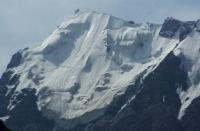Вы здесь
Climbing to peak Pobeda.

Guided walking tour to Issyk-Kul lake.
“[In mountaineering, if] we look for private experience rather than public history, even getting to the top becomes an optional narrative rather than the main point, and those who only wander in high places become part of the story”
Rebecca Solnit, Wanderlust «A History of Walking».
Observing excursion in Kyrgyzstan.
Peak Pobeda, is one of three 7000-plus meter giants in Kyrgyzstan. It is mountain full of surprises. At 7439 metres, it is the highest mountain in the Tien Shan range which straddles Kyrgyzstan, Kazakhstan and North-western China.
The mountain actually sits astride the border with China which passes over the summit and along the ridges spreading to the East and West. The South-eastern slopes of the mountain are actually in China. It is part of the Kokshaal Tau (“Forbidding Mountains”) subrange of the Tien Shan and although it is called a “Peak”, Pobeda has a “massif” form with several summits along the length of its ridge, (only one of which actually reaches over 7000 metres).
One of the problems associated with the years has been that of identification. Sixteen kilometres to the North East, separated from it by the South Enylchek glacier, is the mountain Khan Tengri (7010 meters). Over the course of history these two giants have often been confused with each other.
This is probably understandable given the remoteness and difficulty in reaching the mountain – and the fact that whilst Khan Tengri is often clearly visible, Pobeda is more often than obscured by the clouds. Also, Khan Tengri looks more impressive with its pyramidal shape.
Another reason might be that Peak Pobeda was further from the valleys which provide the main access routes to the region, and so appeared smaller than its neighbour. The most famous misidentification of the two mountains was the Russian explorer Semyenov who wrote how he was struck by the distinctive pyramid shape.
However, he was not the only person to confuse the two as there is some confusion in the historical texts and some people think that both peaks may have been known by the name Khan Tengri by different peoples at different times.
In 1938, the first attempt to ascend to the summit of the mountain was made by a team of mountaineers – but it is not clear if they actually succeeded. They named it “Peak 20 years of Komsomol” – in honour of the Communist youth movement.
It was only in 1943 that a somewhat surprised survey team ascertained that Pobeda was the higher than Khan Tengri and it regained its rightful place in the record books. (It didn’t help that, apparently, the mountaineers were using an aircraft altimeter which kept giving erroneous readings.
It was only later following subsequent expeditions that the readings were verified.) Anyway, the matter was settled in 1946 when the peak received the name by which it is now known –in honour of the victory over Fascism in the Second World War (“Peak Pobeda” means “Victory Peak” in Russian).
To confuse the unwary still further, the mountain is now officially known as “Jengish Chokusu” – which is a translation of “Peak Pobeda” into Kyrgyz, although it is still referred to everywhere by the Russian name.
The Chinese, however, still know the mountain by its Chinese name: Tomur Feng. Peak Pobeda is a notoriously difficult mountain to climb, and it has claimed many lives of mountaineers that have attempted to do so.
n 1955 two teams attempted to conquer the peak, (one, from Kazakhstan, from the Chon Tern Pass – and the other, from Uzbekistan, along the Zvezdochka glacier). The Kazakh team met difficulties as a result of worsening weather conditions – and having reached 6000m they decided to descend.
Only one of the 12 member team survived, and he was rescued by chance. From this moment on, the mountain acquired a fearsome reputation. The following year, 1956, saw what is considered by many to be the first generally recognized successful ascent by the 30-day expedition led by Vitaly Ablakov.
Other milestones in the history of the mountain include: 1970, when an expedition made the first successful transit of the complete massif, from East to West and 1990 which saw the first successful winter ascent – in February.
It is not a mountain for the inexperienced climber. It is covered by huge masses of ice and snow and weather conditions can also make ascents difficult as persistent, strong, cold winds (called “Thousand Devils”) can whip up snowstorms – and have been known to rip tents to shreds.
Several expeditions, however, make attempts on the summit each year – supported by local firms which maintain base camps on the Enylchek glacier. There have even been several expeditions to ski down the impressive slopes.
Authority:
"Discovery Travel” Magazine. www.centralasia.travel
Photos by
Alexander Petrov and Vladimir Serbenko.







